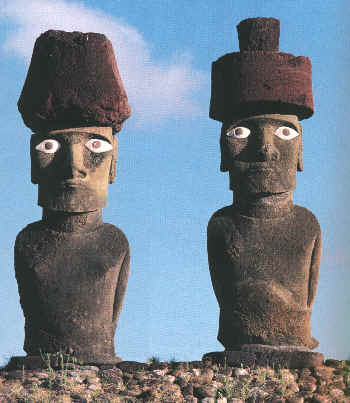
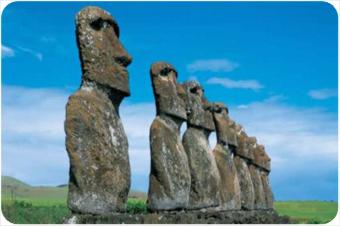
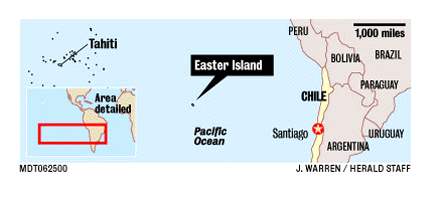
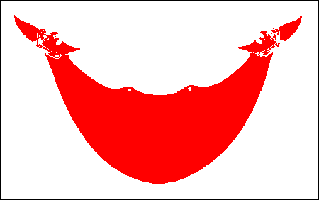
Native Flag of Easter Island - Reimiro
Easter Island is the world's most isolated inhabited island. It is also one of the most mysterious. Easter Island is roughly midway between Chile and Tahiti. The triangular shaped island is made mostly of volcanic rock. Small coral formations exist along the shoreline, but the lack of a coral reef has allowed the sea to cut cliffs around much of the island. The coastline has many lava tubes and volcanic caves. The only sandy beaches are on the northeast coast.
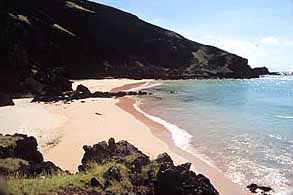
Ovahe Beach, North Shore
The inhabitants of this charming and mysterious place called their land: Te Pito o TeHenua, 'the navel of the world.'
It sits in the South Pacific Ocean 2,300 miles west of South America, 2,500 miles southeast of Tahiti, 4,300 miles south of Hawaii, 3,700 miles north of Antarctica. The closest other inhabited island is 1,260 miles away - tiny Pitcairn Island where the mutineers of the H.M.S. Bounty settled in 1790.
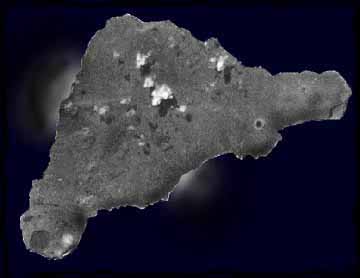
Archaeological evidence indicates discovery of the island by Polynesians at about 400 AD.
In 1722, a Dutch explorer, Jacob Roggeveen, sighted and visited the island. This happened to be on a Sunday, Easter Sunday to be precise, and the name stuck: Easter Island (Isla de Pascua in Spanish).
What he discovered on Easter Island were three distinct groups of people, Dark skinned, Red skinned, and very Pale skinned People with red hair".
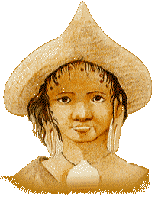
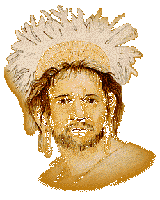
The Polynesian name of the island is Rapanui, which is a name given by a Tahitian visitor in the 19th century who says that the island looked like the Tahitian island of 'Rapa,' but bigger, 'Nui.'
Inhabitants are of Polynesian descent, but for decades anthropologists have argued the true origins of these people, some claiming that ancient South-American mariners settled the island first.
What many early explorers who visited the island found, was a scattered population with almost no culture they could remember and without any links to the outside world.
The Easter islanders were easy prey for 19th century slave traders which depreciated even more their precarious culture, knowledge of the past, and skills of the ancestors.
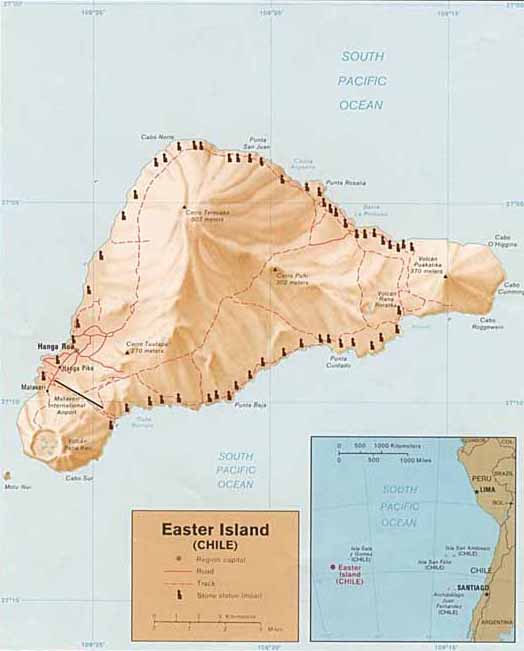
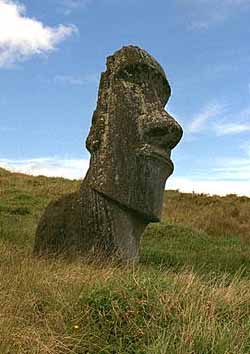
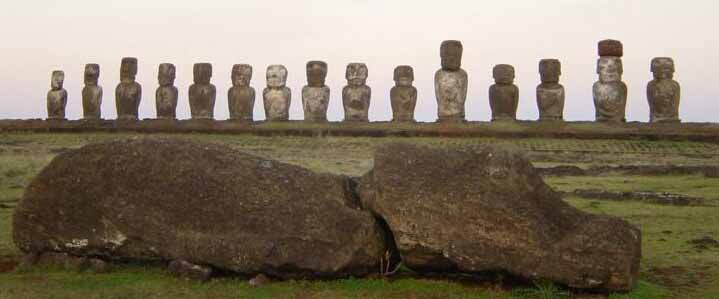
When we think of Eastern Island we think of of huge stone carved figures - monoliths- that dot the coastline. They are called Moai - (pronounced moe-eye). Moai are statues carved of compressed volcanic ash on Rapa Nui (Easter Island). The statues are all monolithic, that is, carved in one piece. However, less than about one-fifth of the statues that were moved to ceremonial sites and then erected once had red stone cylinders pukau placed on their heads. These "topknots," as they are often called, were carved in a single quarry known as Puna Pau.
About 95% of the 887 moai known to date were carved out of compressed volcanic ash at Rano Raraku, where 394 moai still remain visible today. Recent GPS mapping in the interior will certainly add additional moai to that count. The quarries in Rano Raraku appear to have been abandoned abruptly, with many incomplete statues still in situ.
However, the pattern of work is very complex and is still being studied. Practically all of the completed moai that were moved from Rano Raraku and erected upright on ceremonial platforms were subsequently toppled by native islanders in the period after construction ceased.
Although usually identified as "heads" only, the moai are actually one piece figures with heads and truncated torsos.
The most widely-accepted theory is that the statues were carved by the Polynesian colonizers of the island beginning by about A.D. 1000-1100. In addition to representing deceased ancestors, the moai, once they were erect on ceremonial sites, may also have been regarded as the embodiment of powerful living chiefs. They were also important lineage status symbols.
The moai were carved by a distinguished class of professional carvers who were comparable in status to high-ranking members of other Polynesian craft guilds. The statues must have been extremely expensive to craft; not only would the actual carving of each statue require effort and resources, but the finished product was then hauled to its final location and erected.
It is not known exactly how the moai were moved but the process almost certainly required human energy, ropes, wooden sledges and/or rollers. Another theory is that the moai may have been "walked" by rocking them forward.
By the mid-1800s, all the moai outside of Rano Raraku and many within the quarry itself had been knocked over. Today, about 50 moai have been re-erected on their ceremonial sites.
Ancient island legends speak of a clan chief called Hotu Matu'a, who left his original home in search of a new one. The place he chose is now known to us as Easter Island. When he died, the island was divided between his six sons and then, later, sub-dividied among their descendants.
The islanders may have believed that their statues would capture the chiefs' "mana" (supernatural powers). They may have believed that by concentrating mana on the island good things would result, rain would fall and crops would grow. The settlement legend is a fragment of what was surely a much more complicated and many-faceted, mythic sketch, and it has changed over time.
Ron Fisher in his work Easter Island Brooding Sentinels of Stone, mentions as one explanation for the statues that "two classes of people, the-so-called Long Ears and Short Ears, lived on the island. The Short Ears were enslaved by the Long Ears, who forced the Short Ears to carve the Moai. After many generations and during a rebellion, the Short Ears surprised the Long Ears killing them all, which explains the abrupt end of the statue-carving.
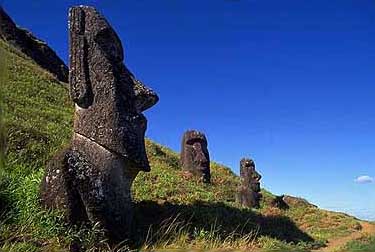
Long Ears
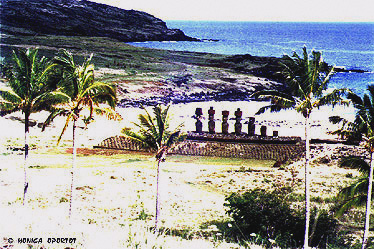
most face inland to watch over the villlages.
Many of the were buried up to their shoulders and thereby appearing as disembodied heads.
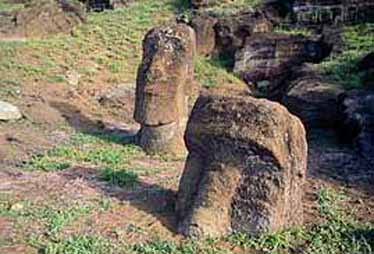
All of the Moai were toppled in tribal wars about 250 years ago. Many have recently been rebuilt - starting in the 1950's. They sit on rocky lava strewn about telling a story of fallen monuments of a long lost civilization who created them. The Moai were depictions of their ancestors. The Rapa Nui were ancestor worshipers and only had one diety - Make Make. The Moai were excavated for the first time by Thor Heyerdahl in the 1950's and were photographed at that time.
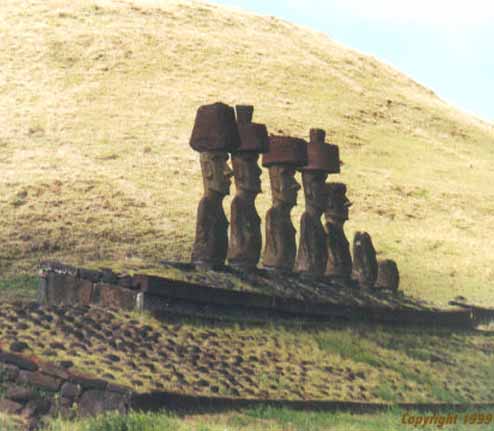
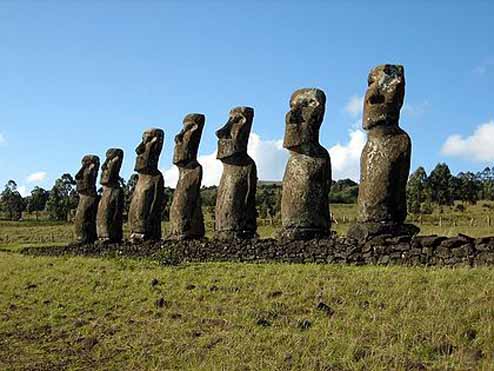
Moai sit on platforms - ceremonial shrines called Ahu.
Ahu Akivi is an especially sacred place. Ahu Akivi is a sanctuary and celestial observatory built about 1500 AD which was the subject of the first serious restoration accomplished on Easter Island by archaeologists William Mulloy and Gonzalo Figueroa, with excellent results.
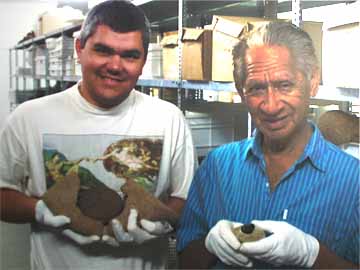
As in the case of many religious structures on Easter Island, it has been situated with astronomical precision: it's seven statues look towards the point where the sun sets during the equinox.
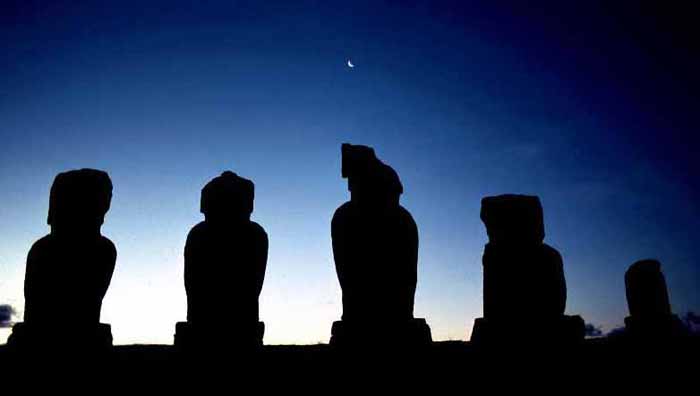
Aligned with the moon
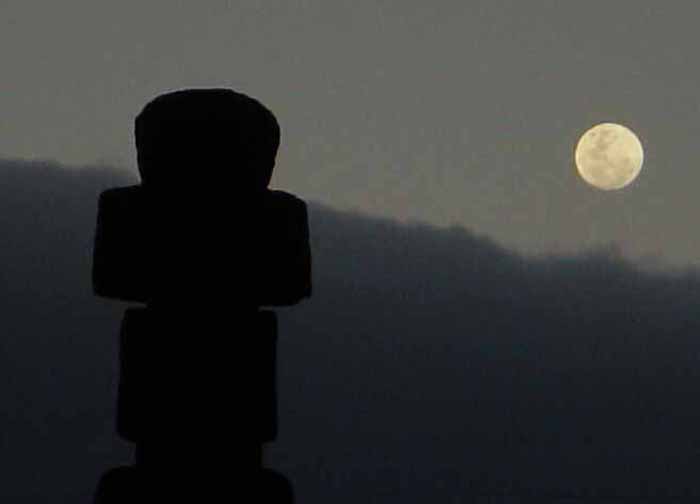
Ahu Akivi is an unusual site in several respects. A low ahu supports 7 statues all very similar in height and style. The site is odd in that it is located far inland and the statues were erected to face the ocean. The only site where this was done. Like other Easter Island sites the statues were found knocked off the ahu, lying face down in the ground. In 1960, Archeologist William Mulloy's team spent several months raising the statues to their original positions.
During the excavation and restoration of this site many cremation pits were uncovered behind the ahu. The pits contained fragments of bone, shells, fishing implements, and obsidian flakes. Whether sites like these were used regularly for cremations and or burials is not certain. At other sites skeletons have been found buried within the ahu structure, but these burials are believed to have occurred after the statues were toppled.
Folklore holds that its seven moai represent the seven young explorers that legend says the Polynesian King Hotu Matu'a dispatched from across the seas, probably from the Marquesas Islands, to find this new homeland for him and his people. They are among the few moai that face the sea.
These seven stone giants may well symbolize those seven explorers, but no one knows for sure. Just as no one knows what any of the moai really represent or why only a few of them face the sea.
The generally accepted theory is that these majestic stone statues were built to honor Polynesian gods and deified ancestors such as chiefs and other figures important in the island's history. Most of them are attributed to the 14th and 15th centuries, although some were erected as long ago as the 10th Century.
Their function, it is believed, was to look out over a village or gravesite as a protector. They may also have been status symbols for villages or clans.
The seven at Ahu Akivi each stand about 16 feet high and weigh about 18 tons. The tallest moai on the island exceed 30 feet. Moai in the range of 12 to 20 feet are common. Even the occasional tiny moai that you come across are at least 6 feet high.
The ahu of Easter Island vary in length - the longest one is 300 feet, while some that hold one moai are only several feet long. Each ahu has a stone masonry base that slopes upward to a high terrace upon which the moai rest. Some terraces are as high as 15 feet above ground level. All are fairly wide - the bases of the moai that stand upon them measure as much as 10 feet long by 8 or 9 feet wide.
The island's volcanic rock from which they were carved is softer and lighter than most other rock, but even the smallest moai weighs several tons. Some of the moai have been estimated to weigh as much as 80 to 90 tons.
Many of the moai - there are hundreds of them - are erected at sites miles from the quarry at which they were carved. How could so few people move them even a couple of feet, let alone several miles, and without breaking them?
And once they did move them, how did they erect them? Even today, using powerful cranes, it would be no simple task.
Many Rapa Nui people believe that the statues were moved and erected by 'mana' a magical force. Great kings of a long-gone era simply used their mana to command the moai to move to the distant sites and stand there. Mana is a word and concept you hear frequently in South Seas lore. The people of Rapa Nui believed that the moai also possessed mana, which was instilled at the time their white coral eyes were put in place, and that the moai used their mana to protect the people of the island. Today none of the moai have genuine coral eyes - and thus the mana is no more.
The intervention of Extraterrestrials - the most infamous of these writers is Erich Von Daniken who suggests that a small group of 'intelligent beings' were stranded there and taught the natives to make 'robot-like' statues. His main thrust is that the stone from which the statues are made is not found on the island- a complete fabrication. This links with theories that Easter island was once part of the lost civilization of flying machines.
Other theories include - men sliding the moai along on layers of yams and sweet potatoes.
The generally accepted belief is that they were transported on sledges or log rollers and then levered erect using piles of stones and long logs.
Thor Heyerdahl, whose books Kon-Tiki and Aku-Aku stirred great interest in Easter Island, conducted an experiment showing that an upright stone statue could be moved using ropes, tilting and swiveling it along. But the experiment was conducted on a flat surface for only a short distance, and this theory, like Heyerdahl's theory that the islands of the South Pacific were settled from east to west from South America rather than from west to east from Southeast Asia, is not considered plausible.
All but a few of the moai of Easter Island were carved at Rano Raraku, a volcanic cone that contains a crater lake. It is an eerie spot. Scattered all around Rano Raraku are 394 moai in every stage of evolution. Some are fallen - a common sight around the island - and some appear to have only heads, although they are really full figures that have been nearly buried by soil over the centuries. For reasons that remain a mystery, it appears that the workers at Rano Raraku set down their tools in the middle of a multitude of projects - and the moai-building abruptly ceased.

Rongo-rongo is the hieroglyphic script of Easter Island. It has remained a mystery since its discovery. For over a hundred years, controversy has raged over the meaning and source of these enigmatic characters.
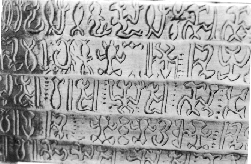
Rongo-rongo Tablet
There are only 21 known tablets in existence - scattered in museums and private collections. Tiny, remarkably regular glyphs, about one centimeter high, highly stylized and formalized, are carved in shallow grooves running the length of the tablets. Oral tradition has it that scribes used obsidian flakes or shark teeth to cut the glyphs and that writing was brought by the first colonists led by Hotu Matua. Last but not least, of the twentyone surviving tablets three bear the same text in slightly different "spellings", a fact discovered by three schoolboys of St Petersburg (then Leningrad), just before World War II.
In 1868 newly converted Easter Islanders send to Tepano Jaussen, Bishop of Tahiti, as a token of respect, a long twine of human hair, wound around an ancient piece of wood. Tepano Jaussen examines the gift, and, lifting the twine, discovers that the small board is covered in hieroglyphs.
The bishop, elated at the discovery, writes to Father Hippolyte Roussel on Easter Island, exhorting him to gather all the tablets he can and to seek out natives able to translate them. But only a handful remain of the hundreds of tablets mentioned by Brother Eyraud only a few years earlier in a report to the Father Superior of the Congregation of the Sacred Heart.
Some say they were burnt to please the missionaries who saw in them evil relics of pagan times. Some say they were hidden to save them from destruction. Which side should we believe? Brother Eyraud had died in 1868 without having ever mentioned the tablets to anyone else, not even to his friend Father Zumbohm, who is astounded at the bishop's discovery. Monsignor Jaussen soon locates in Tahiti a laborer from Easter Island, Metoro, who claims to be able to read the tablets. He describes in his notes how Metoro turns each tablet around and around to find its beginning, then starts chanting its contents.
The direction of writing is unique. Starting from the lefthand bottom corner, you proceed from left to right and, at the end of the line, you turn the tablet around before you start reading the next line. Indeed, the orientation of the hieroglyphs is reversed every other line. Imagine a book in which every other line is printed backtofront and upsidedown. That is how the tablets are written! Jaussen was not able to decipher the tablets.

There are also many zoomorphic figures, birds especially, fish and lizards less often. The most frequent figure looks very much like the frigate bird, which happens to have been the object of a cult, as it was associated with MakeMake, the supreme god.
When you compare the tablets which bear the same text, when you analyze repeated groups of signs, you realize that writing must have followed rules. The scribe could choose to link a sign to the next, but not in any old way. You could either carve a mannikin standing, arms dangling, followed by some other sign, or the same mannikin holding that sign with one hand. You could either carve a simple sign (a leg, a crescent) separate from the next, or rotate it 90 degrees counterclockwise and carve the next sign on top of it.
All we can reasonably hope to decipher some day is some two to three lines of the tablet commonly called Mamari. You can clearly see that they have to do with the moon. There are several versions of the ancient lunar calendar of Easter Island.
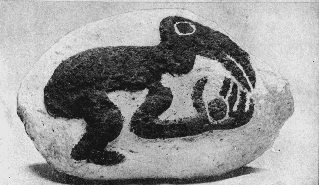
On Easter Island, petroglyphs are located in every sector of the island where there are suitable surfaces. Favored locations are smooth areas of lava flow (called "papa" in Rapanui), or on smooth basalt boulders. Most of these surfaces occur along coastal areas and often are associated with major ceremonial centers. Some important ahu have, as part of their structure, elegantly carved basalt stones (pa'enga), with petroglyphs on them. Paintings survive in caves or in some of the stone houses at 'Orongo where they are protected against the weathering process.
Thousands of petroglyphs - rock carvings - can be found on Easter Island. Many represent animals, notably birds or anthropomorphic birdmen.
One of the most famous motifs on Easter Island is that of birdman - a half-man, half bird image that was connected to cult events at the sacred site of 'Orongo. A bit of background on the culture is necessary to explain this unusual cult.
After the demise of the statue building, in the last days before the invasion by Peruvian slave traders, there arose a cult of the Birdman (Tangata Manu). The birdman was seen as the representative on earth of the creator god Makemake, and eventually, this cult surpassed the traditional power of the king ariki.
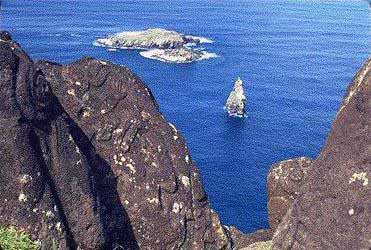
Once a year, representatives from each clan would gather at the ceremonial village of Orongo and swim to Motu Nui, a nearby Islet to search for the egg of the Sooty Tern. On his return, the competitor presented the egg to his representative who was then invested with the title of Tangata Manu. He then went down to Mataveri and from there was led in procession to the southwest exterior slope of Rano Raraku, where he remained in seclusion for a year. The Birdman ritual was still in existence when Europeans arrived on Easter Island - therefore historically documented. It was also featured quite prominently in Kevin Costner's film "Rapa Nui".
In Hanga Roa -a sprawling and pleasant community where the island's 2,775 residents live because it's the only area on the island with electricity and running water. The most interesting souvenirs are miniature wood and stone carvings of moais, though some stone samples up to 6 feet tall are available.
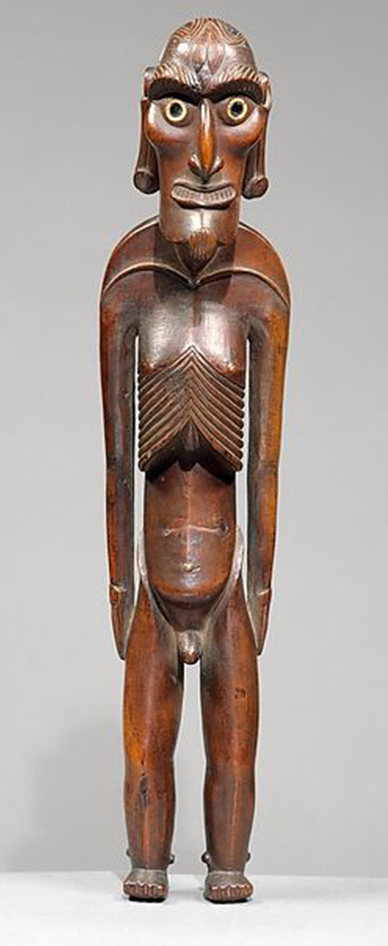
Moai Kavakava
A bearded emaciated man whose ribs and vertebrae are grotesquely extended.
It is said to represent the spirits of dead ancestors.
According to the local tradition, as Chief Tuu-ko-ihu was returning home, he saw two such spirits who had protruding ribs and hollow bellies. These Aku Aku later appeared to him in a dream.
Other Rapa Nui wood carvings include: statues of female figures (moai pa'a pa'a), paddles (rapa), clubs (ua), staffs ('ao), lizards and birdman images (tangata manu).
Today, most of the original wood sculptures reside in museums around the world - estranged from their ancestral home. The islanders still carve these statues; continuing a tradition which, to this day, commands respect and admiration from visitors.
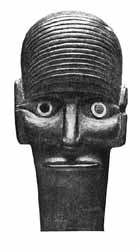
M.H. de Young Memorial Museum
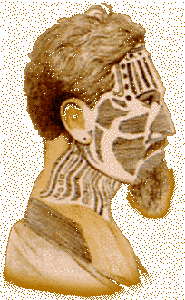
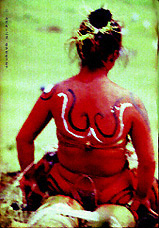
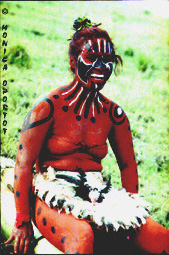
Wearing a tatoo in various parts of the body is a popular custom.
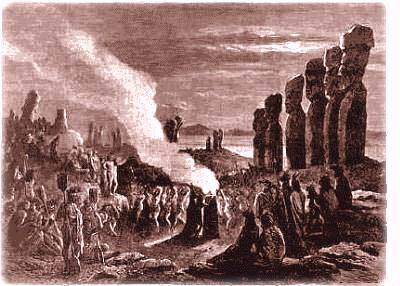
Every Easter Islander knows that his ancestors were kai-tangata, 'man-eaters'. Some make jokes about it, others take offense at any allusion to this custom which has become in their eyes barbarous and shameful.
According to Father Roussel, cannibalism did not disappear until after the introduction of Christianity. Shortly before this, the natives are said to have eaten a number of men, including two Peruvian traders. Cannibal feasts were held in secluded spots, and women and children were rarely admitted. The natives told Father Zumbohm that the fingers and toes were the choicest morsels.
The captives destined to be eaten were shut up in huts in front of the sanctuaries. There they were kept until the moment when they were sacrificed to the gods.
The Easter Islanders' cannibalism was not exclusively a religious rite or the expression of an urge for revenge: it was also induced by a simple liking for human flesh that could impel a man to kill for no other reason than his desire for fresh meat. (Man was the only large mammal whose flesh was available) Women and children were the principal victims of these inveterate cannibals. The reprisals that followed such crimes were all the more violent because an act of cannibalism committed against the member of a family was a terrible insult to the whole family. As among the ancient Maoris, those who had taken part in the meal were entitled to show their teeth to the relatives of the victim and say, 'Your flesh has stuck between my teeth'. Such remarks were capable of rousing those to whom they were addressed to a murderous rage not very different from the Maly amok.
- Easter Island - A Stone-Age Civilization of the Pacific
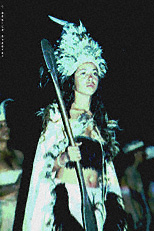
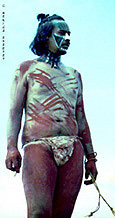

Go on your own Easter Island adventure MSNBC, November 8, 2005 , Matt Lauer from the 'Today Show' visited Easter Island this week. The Moai were the main topic of conversation. Moai eyes have been discovered beneath the fallen statues and are being placed in the restored statues.
They call the eye 'Mata'.
'Mata' reminded me of an archived article mentioning the Greek word Mati, Eye.
I discovered Matariki the Maori name for the constellation Pleiades or Seven Sisters. Literally it means "little eyes" mata riki or "eyes of god" mata ariki.
The Eye is the God, All Seeing Eye, Masonic Program, Lens of Time, the creational source through which consciousness experiences in physical reality.
Too Kuhu, tahonga rotu, Mata Mau hata. This references the god Kuhu [reminiscent of the Egyptian Pharaoh Khufu, Cheops, allegedly builder of the Great Pyramid at Giza] who is a priest bringing gifts when the Pleiades are rising. In Easter Island beliefs, the Pleiades were connected with the sun during the harvest time.
The Old Rapanui name 'Mata Ura', 'The red eye' is the designation of Mars.
2012 is our program designation, return through the eye of consciousness in the alchemy of time.
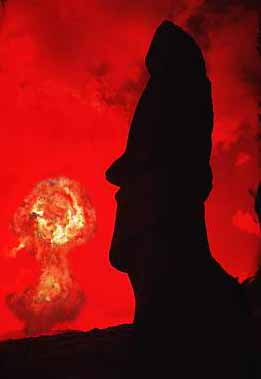
- Alfred Metraux's Ethnology of Easter Island -1971
The ancestors of the natives of Te Pito O Te Kainga ("A Little Piece of Land", later called Rapa Nui by other Polynesians and Easter Island by Europeans) came from two places known as Marae Renga and Marae Tohio in a land called Maori ("Land of the Native People"), or Hiva ("Black"; perhaps a reference to the basalt of volcanic islands, perhaps Mangareva; Hiva was a Polynesian name for the Marquesas Islands).]
In Hiva, Hau Maka had a dream in which his spirit traveled to a far country, looking for a new residence for his king Hotu.1 His spirit arrived at three small islands (Motu Nui, Motu Iti, Motu Kao-kao) and a big hole (the volcanic crater of Rano Kau) on the southwest corner of Te Pito O Te Kainga.
The spirit traveled counter-clockwise around the island, naming twenty-eight places including Anakena (an anchorage on the north coast of the island and future residence of the king); Papa o Pea (where young princes would be raised), and Ahu Akapu (where the abdicated king would live). When Hau Maka awoke he told his brother Hua Tava about the dream.
The island was the eighth, or last, island in the dim twilight of the rising sun. He named the island "Te Pito O Te Kainga A Hau Maka" ("The Little Piece of Land of Hau Maka"). Hua Tava told his brother to tell king Hotu Matua of the new land.
fter hearing about the dream, Hotu Matua ordered Hau Maka to send some young men to explore the island. Hotu Matua told his two sons Ira (the first born) and Raparenga, and Hua Tava's five sons-Kuukuu, Ringiringi, Nonoma, Uure, and Makoi-to build a canoe and search for the island of Hau Maka's dream. He gave them the directions to the island:
i lunga (upwind; i.e., southeastly, into the southeast tradewinds)
e tau (it juts out)
e revareva ro a (as a permanent contour)
i roto i te raa (in the midst of the [rising] sun)
He told them that there were three islets and a big hole, also a long and beautiful road. So the seven men left in a canoe stocked with yams, sweet potatoes, bananas, and other foods.
The canoe was named Oraora-ngaru ("Saved from the waves"), or Te Oraora-miro ("The pieces of milo wood lashed together").
They left on the 25th day of Vaitu Nui (April) and arrived on the 1st day of Maro (June), a voyage of five weeks.2 The explorers found the three islets and the big hole.
They sailed on to Hanga Te Pau, where they landed. Makoi was placed in charge of marking and naming the land. Kuukuu was placed in charge of farming.
On the tenth day of Maro (June), they climbed the slopes of Rano Kau. Kuukuu planted the yams. On the fifth day of Anakena (July), the explorers began to go around the island counterclock-wise, starting with the south coast.
They followed the footsteps of Hau Maka's dream soul and named the places as Hau Maka had named them. When fish swarmed near shore at Hanga-o-honu (Bay of Turtles, on the north coast), they caught the fish with their hands and tossed them ashore. They cooked and ate the fish there.
When they were near Anakena, Ira saw a turtle and tried to lift it, but it was too heavy for him; Raparenga tried and failed. Kuukuu tried and lifted the turtle off the ground, but it struck him and broke his spine. The turtle, which was a spirit (kuhane), swam back to Hiva.
Kuukuu was taken to a nearby cave on the plain of Oromanga. He begged the others not to leave him, but his companions departed after piling six stones outside the cave to take their places and to keep Kuukuu company. Kuukuu died in the cave.
The explorers went to the west side of the island and discovered a surfing spot. They rode a wave to the right and called the place where they landed Hanga Roa; they rode a wave to the left and landed at Apina Iti.
They rode a third wave in and landed by Hanga O Rio. They caught more waves, then went ashore and rested in a cave at Pu Pakakina.
Ira sent the other explorers surfing so he and his brother Raparenga could secretly place some stone figures Ira had brought from Hiva. While the others were surfing, Ira set up three stone figures with necklaces of mother-of-pearl shell.
The shining necklaces could be seen from the ocean: the shells of Ruhi Hepii when a surfer rode a wave to the right, the shells of Pu when a surfer rode the wave to the left, and the shells of Hinariru when the surfer went straight ahead.
Ira sent Makoi around the island to name places with names from the homeland of Hiva. [Sixty place names are given.] After this was done, Ira taught Makoi string figures and the secret content of the figures.
A man named Nga Tavake, who had preceded the explorers onto the island, then appeared, and the six explorers told him, "This is a bad land, for when we planted yams, grass grew up instead." Then they all went to the yam plantation planted by Kuukuu and weeded it.
Ira taught the secret of the shells necklaces and directions to his brother Raparenga; Uure overheard their conversation and tricked Ira into giving the secret to his brother Makoi.
Ira, Raparenga, Uure, Nonoma, and Ringiringi left Te Pito O Te Kainga on the twenty-fifth day of Tangaora Uri (October) to return to Hiva. Makoi remained on Te Pito O Te Kainga. As the canoe left, Makoi chanted the directions back to the island: "There are eight islands.
Te Pito O Te Kainga is the eighth. Once it has been lost, it cannot be found again! Ruhi to the right, Pu to the left, necklace around the figure of Hinariru at Papa O Rae straight ahead!"3
King Hotu Matua ruled Hiva after his father Matua. During Matua's reign, a group of people called the Hanau Eepe came and took one side of the island from the Hanau Momoko, the people whom Matua ruled.
Then the Hanau Eepe tried to move the border to gain more territory. They were captured and imprisoned. In the meantime, Matua told his son Hotu Matua to launch a canoe and immigrate to Te Pito O Te Kainga because a rising tide was destroying their land.
Hotu ordered his assistants Teke and Oti to get plants and animals to take with them on their voyage. The two men gathered banana shoots, taro seedlings, sugarcane, yam, sweet potatoes, hau trees, paper mulberry trees, sandalwood trees, toromiro trees, ferns, rushes, yellow roots, tavari plants, moss, and ngaoho plants, along with birds, pigs, and chickens.
Matua reminded Hotu to take along flies as well, since the number of human beings depended on the number of flies. He told Hotu to take the Hanau Eepe prisoners as well to farm the land.
Hotu then ordered his master canoe builder Nuku Kehu to launch the double-hulled canoe that had been built for the voyage. The canoe sailed on the second day of Hora Nui (September) and arrived at the southwest corner of Te Pito O Te Kainga on the fifteenth day of Tangaroa Uri (October)-a six-week voyage.
In the morning, when the explorers awoke [earlier it was said the explorers had returned to Hiva], two canoes were seen approaching the southwestern tip of the island, off Motu Nui.
The canoes were bound together into a double canoe, but as they came near the land the lashings which united them were cut. One boat named "Oteka" carried Hotu Matua and his wife, Vakai-a-hiva; the other boat, named "Oua," carried Hineriru and his wife, Ava Rei Pua.4
Raparenga signaled with leaves to the voyagers the following message: "The land is bad; yams won't grow because of the weeds." Hotu Matua told Tuki to signal back that Hiva was also a bad land, as the rising tide of the ocean was ruining it. Raparenga then signaled to the voyagers that if they sailed to the right (east), they should stay way out or they would be pushed into the cliffs.
The two canoes traveled in different directions around the island. Hotu Matua went around the southern and eastern coasts of the island.
Five fishing grounds were established through the mana of a man named Honga.
Hineriru went around the western and northern coasts of the island; nine fishing grounds were established through the mana of Teke, who had been transferred to that canoe. Hotu wanted to be the first to reach Anakena (an anchorage on the north side of the island, where the royal residence would be established).
When he saw the other vessel approaching, he ordered a spell chanted, which made his own boat go fast and Hineriru's go slow. Two more fishing grounds were established near Anakena.
The canoe of Hotu Matua landed first at the cove. A son named Tuu Maheke was born there to Vakai and Hotu Matua. Hineriru was a man of intelligence, and wrote rongo-rongo (native script) on paper he brought with him.
Among those who came in the canoes was the ariki (chief) Tuu Ko Ihu, the maker of the wooden images; two of his sons and two grandsons have given their names to four subdivisions of the Miru clan.
On the other canoe, a daughter named Ava Rei Pua Poki was born to Hineriru and Ava Rei Pua (identified as a queen, perhaps the younger sister Hotu Matua).
Vaka, "the master in charge of tying the umbilical cord," performed the rite for Tuu Maheke and then for Ava Rei Pua Poki. The canoes were then brought ashore and taken apart so the wood could be used to make houses. After Nuku Keku (the master canoe builder) finished the houses, seedlings were distributed to the settlers.
Then Hotu Matua told Teke to take the Hanau Eepe and settle them in a suitable place where they would farm the land. Teke took them to Poike, on the southeastern end of the island, and told them "Settle here, work, and keep peace among yourselves!" Iko ("Insect") was installed as the king of the Hanau Eepe.
Among Hotu Matua's company there was a concealed passenger whose name was Oroi; he was an enemy of Hotu, who had killed some of Hotu's children in Hiva, and had hidden himself on board the migration canoe.
He got on shore at Anakena without anyone having guessed at his presence.
One day the five children of a man named Roro went to bathe at Ovahe (a small cove east of Anakena), and as they lay on a rock in the sea, Oroi came from behind and killed them by thrusting a lobster spine up their anuses and pulling out their intestines.5
When the children did not return, the father said to the mother, "Where are the children?"
The mother said, "On the rock."
But when Roro went to look, the rock was covered with water, for it was high tide; by and by when the water went down, he saw the five children were dead.
Roro then told Hotu Matua: "Oroi, that bad man, is here, for he has killed my children.
Now Hotu Matua went to see his adopted daughter Veri Hina, who was married and who lived at Mahatua (past Ovahe on the north coast). Oroi put a noose in his path and tried to catch his foot in it, but Hotu avoided it by stepping to one side.
When he had finished his visit to his adopted daughter, he said to her and her husband, "Follow me and watch above me.
If the sooty terns circle high above me, I will live; if the terns dive down on me, I have been killed." As he returned, he saw that the noose was still on the path, and he knew his enemy was hidden behind the rock.
Terns circled high above him. This time Hotu Matua intentionally stepped on the noose and fell, and when Oroi came at him with a bone knife, he killed Oroi with a spell-"Spin! Spin! Fall down! Fall down! Die!" Then he called to his adopted daughter and son-in-law to see that Oroi was dead.
When, however, they put the corpse in the oven to cook it, it came to life again, so they had to take it over to the other side of the island to an ahu called Oroi, and there the corpse cooked quite satisfactorily, and they ate it.
Hotu Matua lived in Oromanga, in a house called Hare Tupa Tuu. One day when Hotu's first born son Tuu Maheke was fifteen, Rovi, his food preparer, went to catch eel as a side dish (inaki) for sweet potatoes; he stayed away overnight. Tuu Maheke's mother had gone to dig up and cook the sweet potatoes for him. Tuu Maheke began to cry.
After a while Hotu Matua got a headache and shouted, "Be quiet, you bastard! You crybaby!" Then he left. When Vakai came home, she noticed the swollen eyes of her son and asked why he was crying. He told her what his father had shouted at him.
After cooking the sweet potatoes for her son, Vakai went to the house of Hotu Matu and told him "Tuu Maheke is not a bastard! You are a bastard! Your real father was Tai A Mahia! Kokiri Tuu Hongohongo was your foster father." Hotu Matua replied, "Why didn't you tell me this back in Hiva, our homeland?"
Hotu Matua moved a short distance away and built a house called Hare Pu Rangi. A month later, Vakai came to live with him. They conceived another boy, named Miru. Hotu moved again and built a house called Hare Moa Viviri; Vakai followed him.
Another boy was born, named Tuu A Hotu Iti; then another son was born, named Hotu Iti A Hotu. Hotu moved again, to Hare Moa Tataka, and Vakai followed. Another son was born, named Tuu Rano Kau.
After the last son was born, Hotu and Vakai moved to Te Ngao o Te Honu. Vakai died. Her corpse was carried to Akahanga and buried there. Hotu Matua moved here and there until finally settling at Akahanga.
After a year he moved to Rano Kau, where he lived on the south side of the crater, opposite Orongo. His last task was to fit two stones together. Then he went into his house and laid down.
His children came and received his final blessings. Then he arose and went to Orongo to announce his death.
He looked in the direction of his homeland, Hiva, and called out to his guardian spirits Kuihi and Kuaha: "Let the voice of the rooster of Ariana crow softly. The stem with many roots (i.e., himself) is entering!" Then he fell down and died.
His children carried him on a litter to Akahanga, where he was buried in Hare o Ava. Later his eldest son, Tuu Maheke, cut off the head, dried and cleaned it, painted it yellow, wrapped it in tapa, and hid it in a stone crevice. A man named Ure Honu found the skull while weeding his banana plantation.
A rat (Hotu Matua's spirit) had led him to the hole where the skull was hidden.
When Ure Honu built a new house at Vai Mata, he hung the skull in it.
At the feast for the new house, King Tuu Ko Ihu saw the skull and exclaimed: "Here are the teeth that ate turtles and pigs in Hiva!" He stole the skull and buried it under a stone near his house.
Ure Honu discovered the theft; his foster son told him who had stolen it. Angry, Ure Honu gathered his men and went to the King's house. They tore down a wall looking for the skull, but found nothing. They searched outside, digging up the ground.
The king was sitting on the stone under which the skull was buried. Ure Honu's men lifted the king off the stone, looked under it, and found the skull.
Ure Honu was satisfied and took the skull back home.




0 comments:
Post a Comment